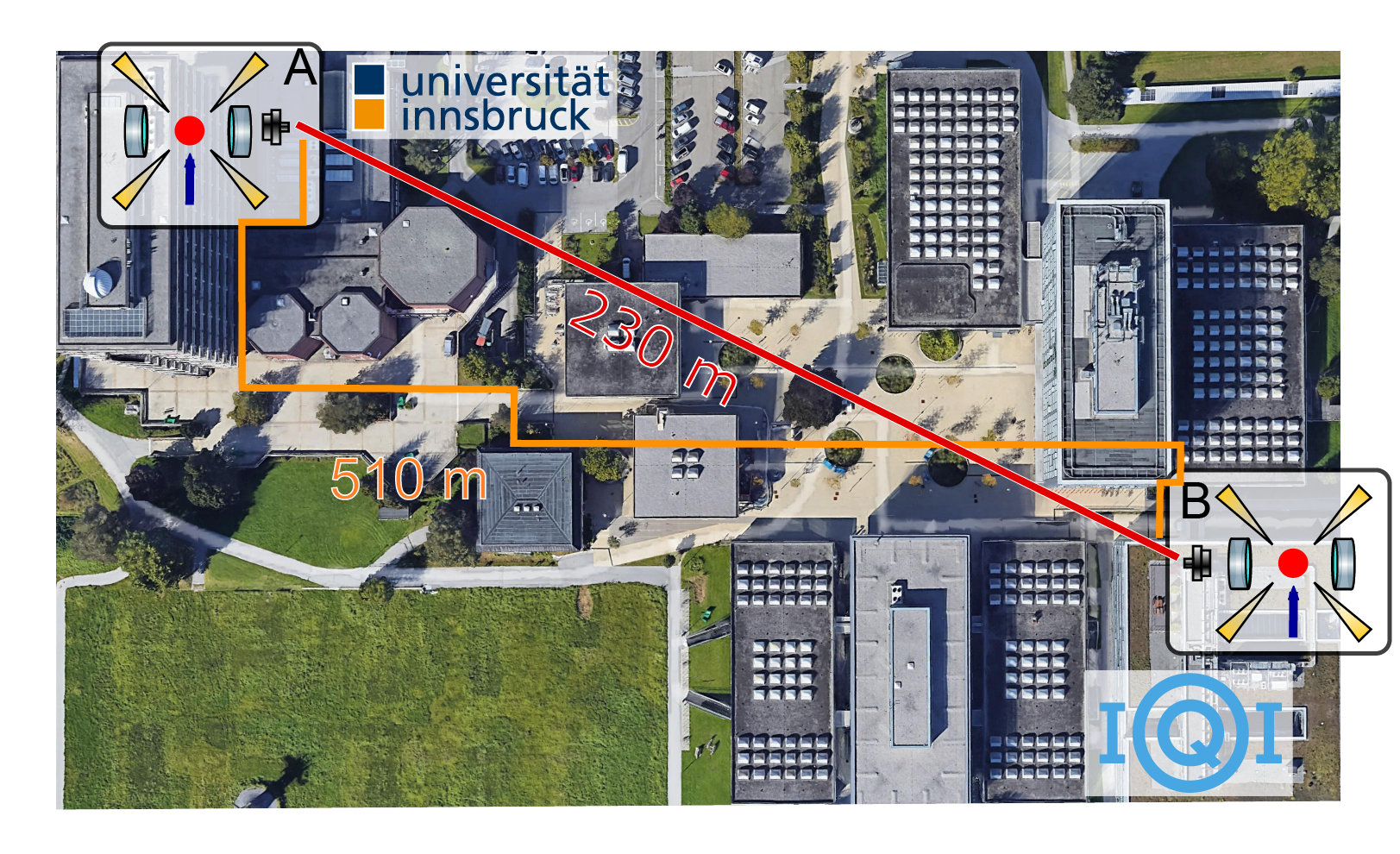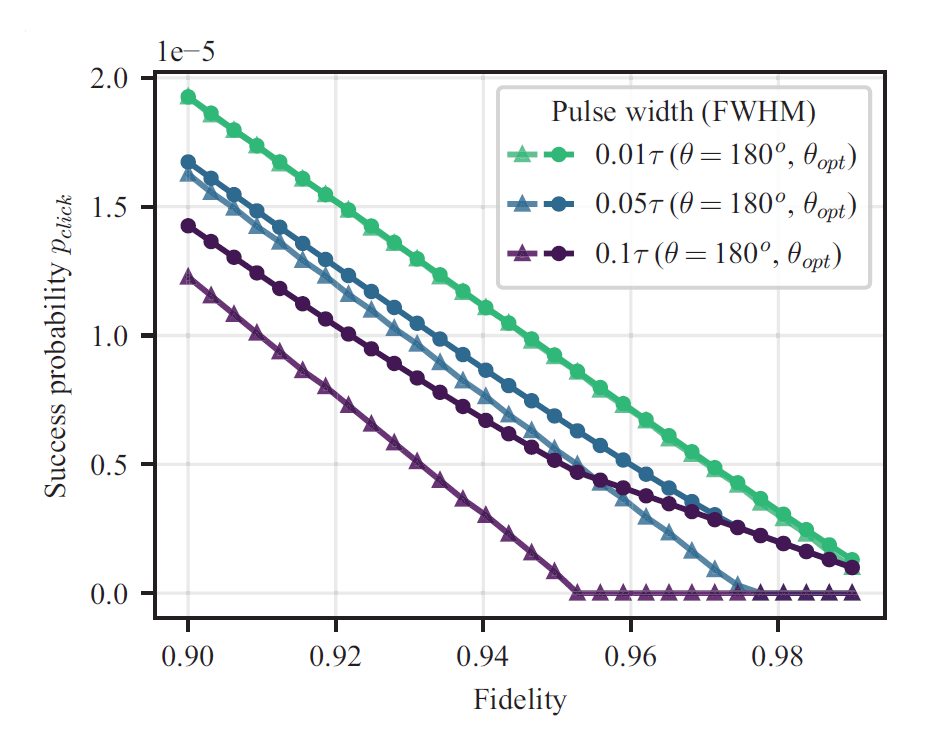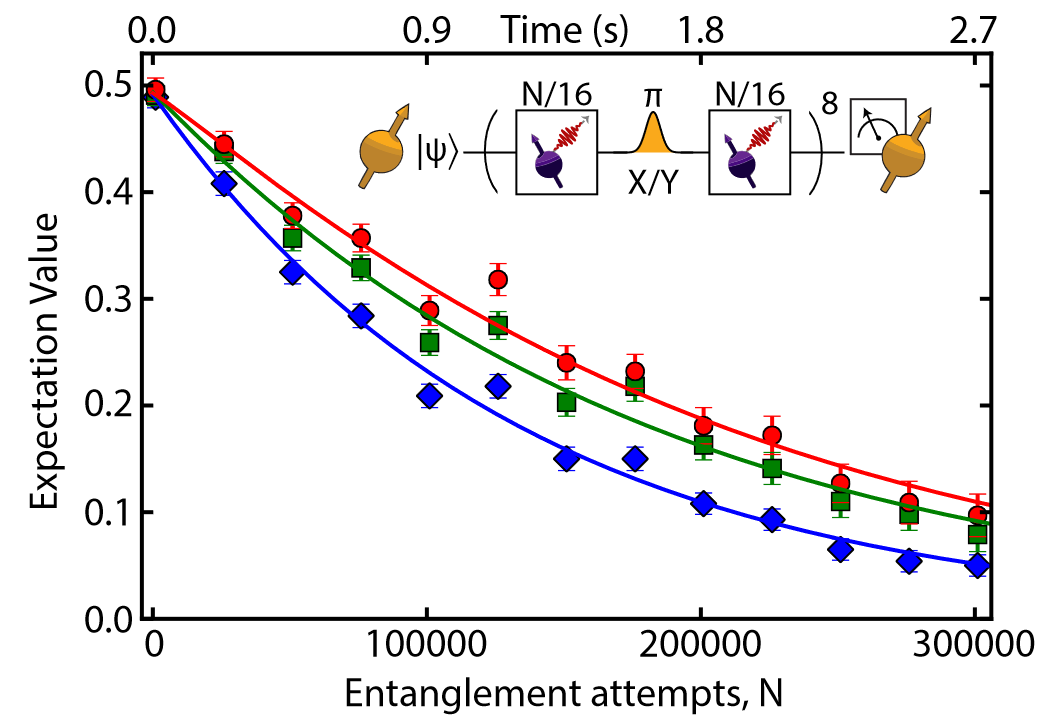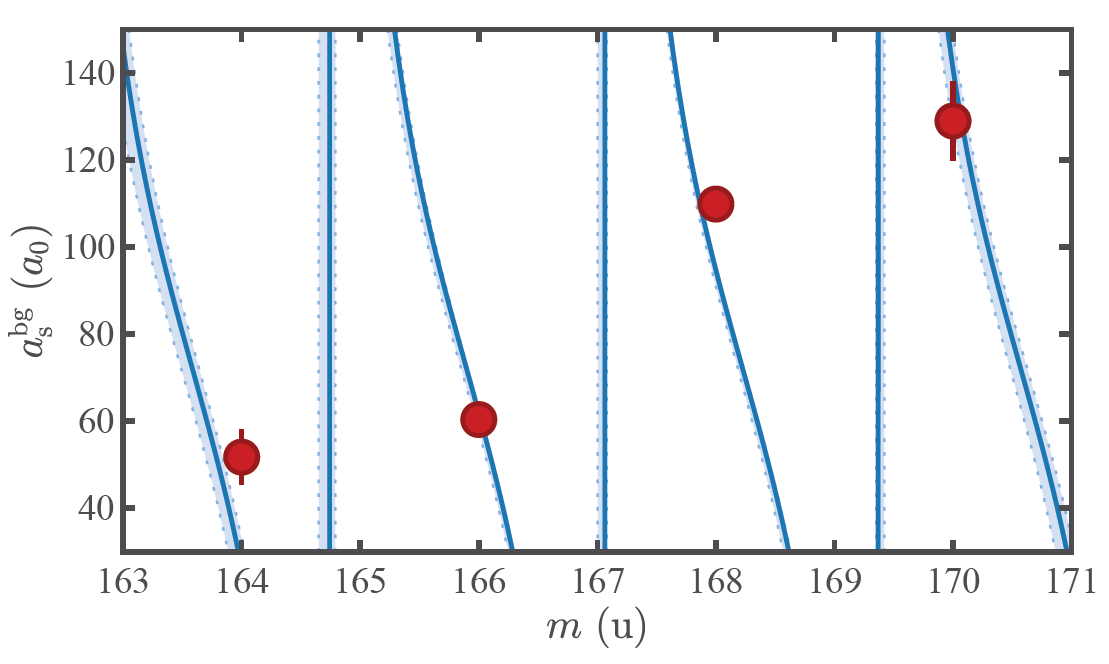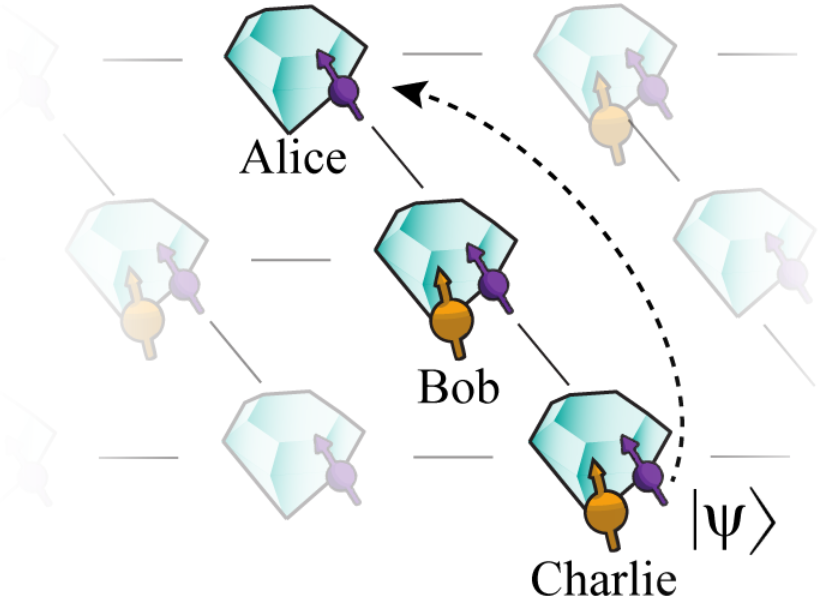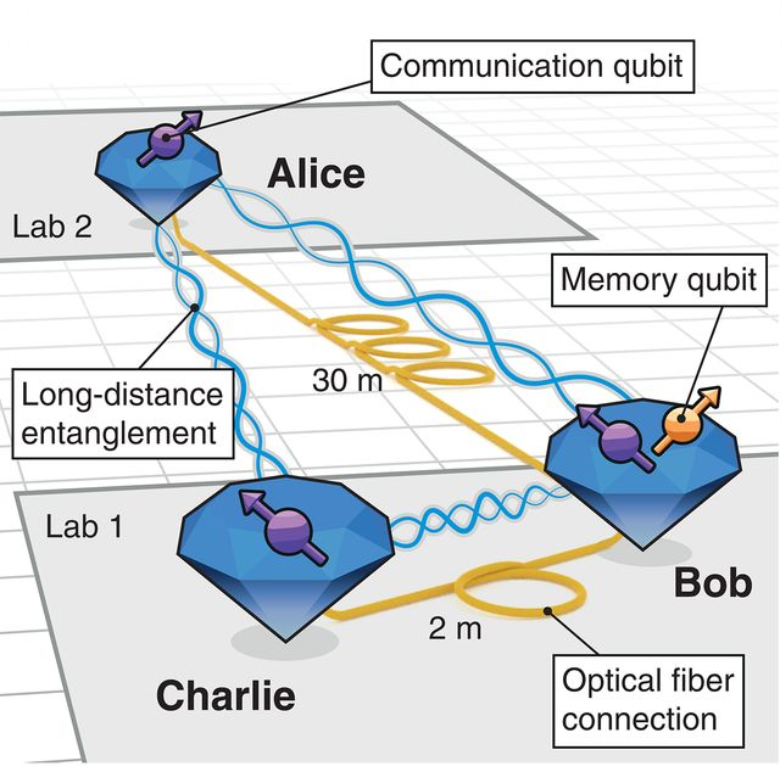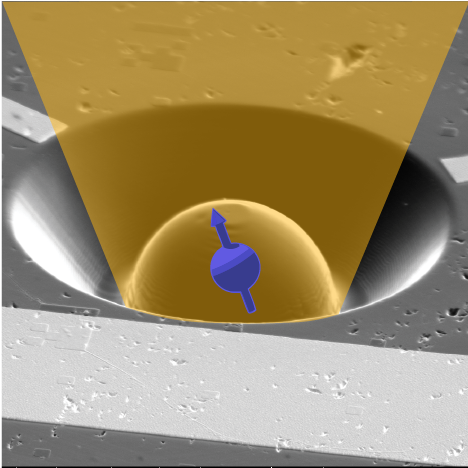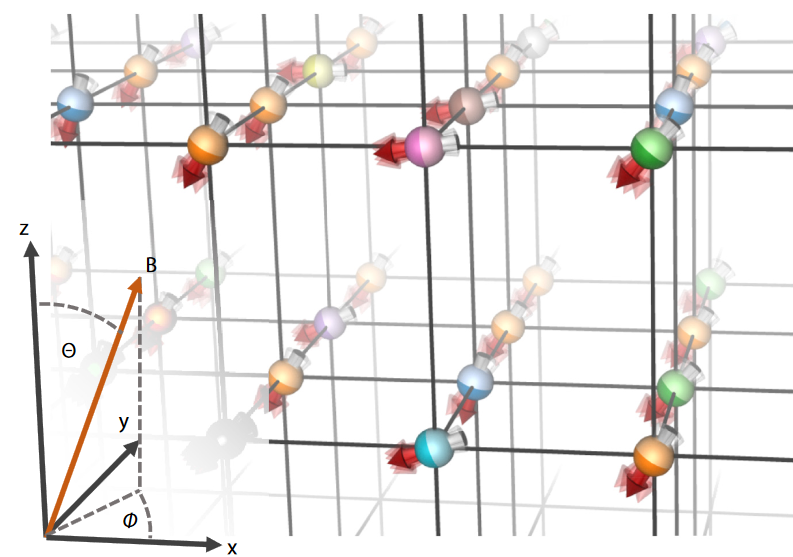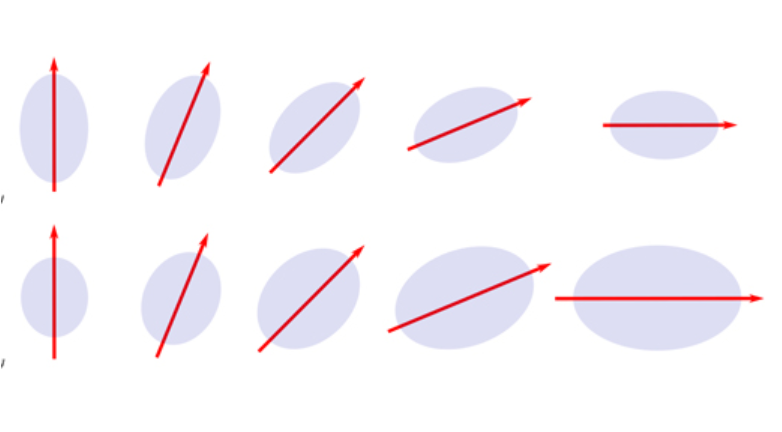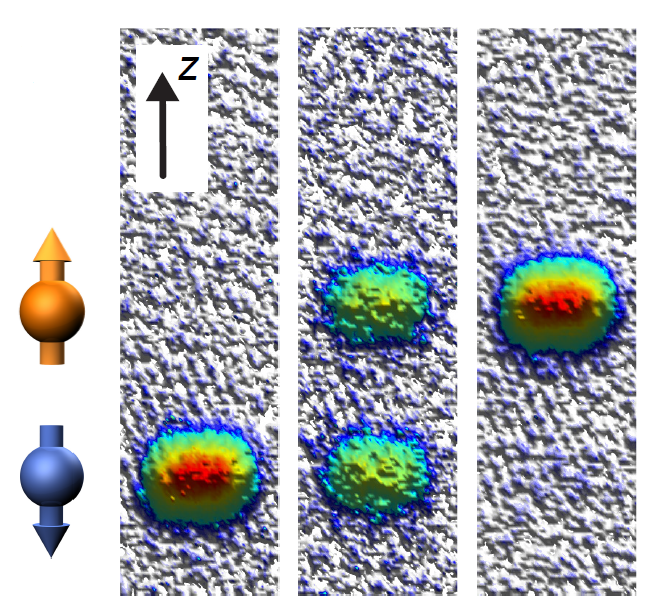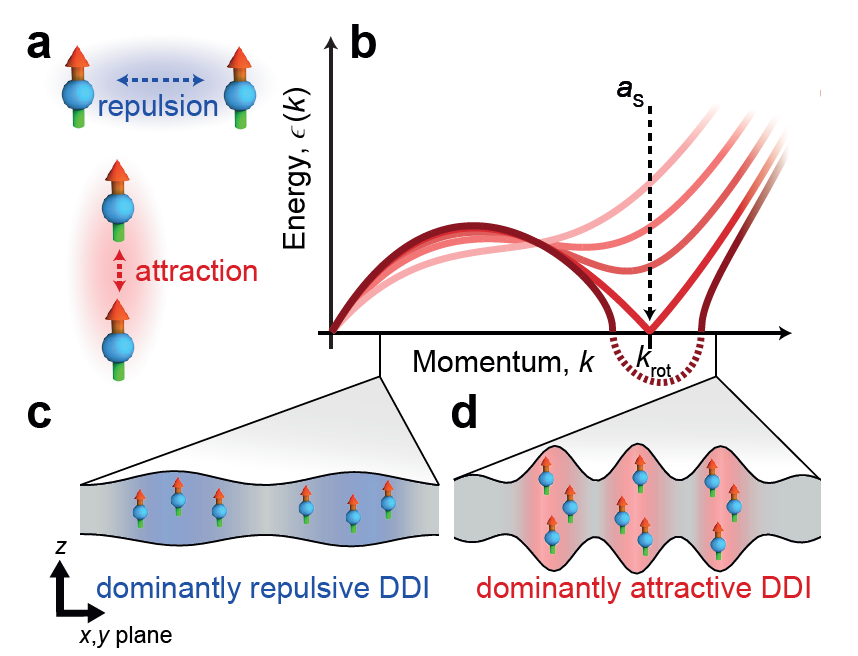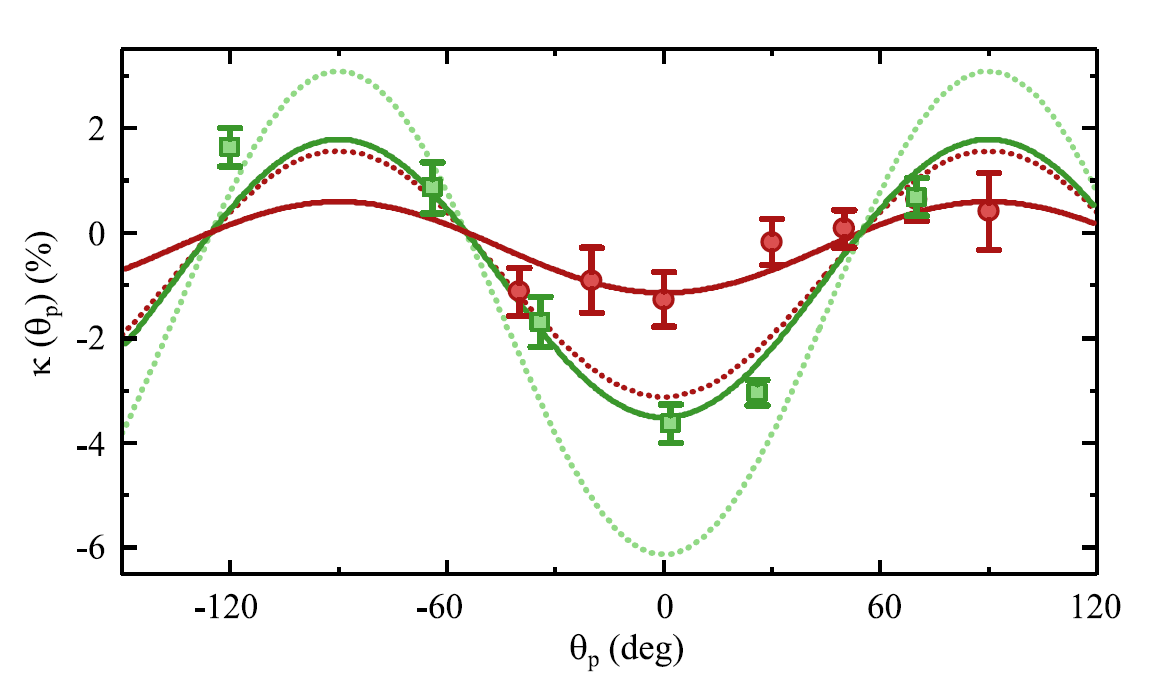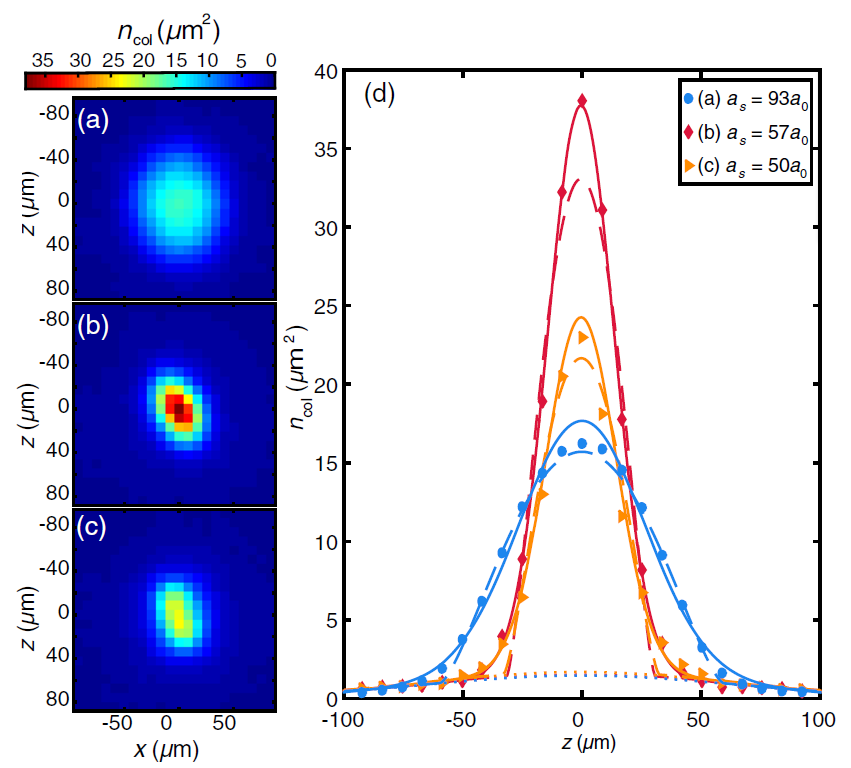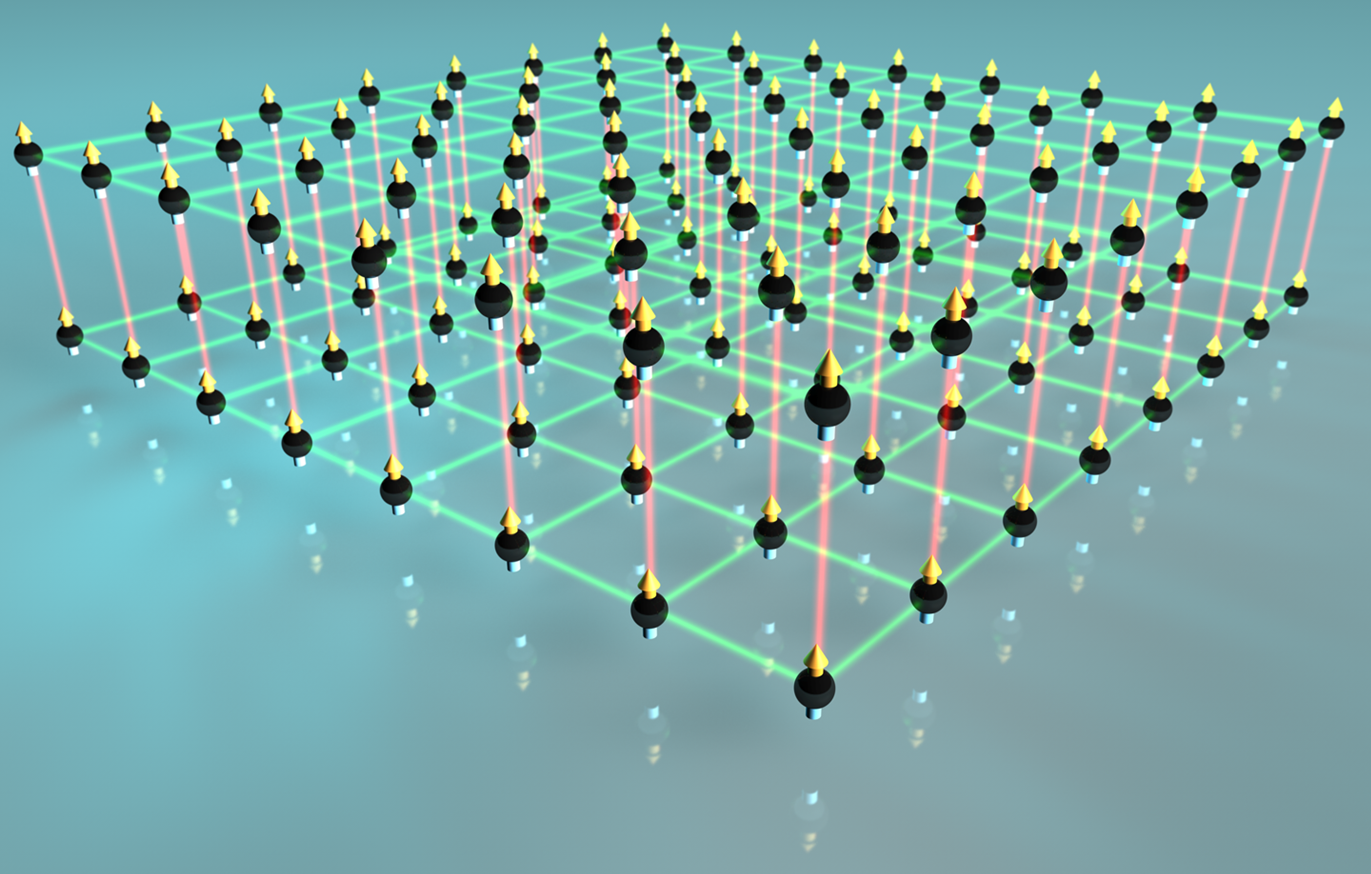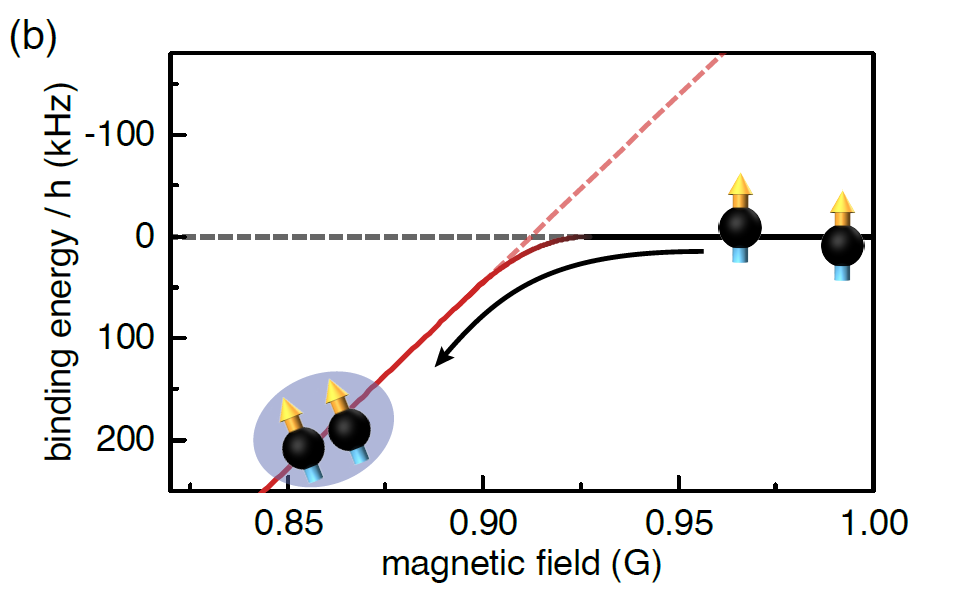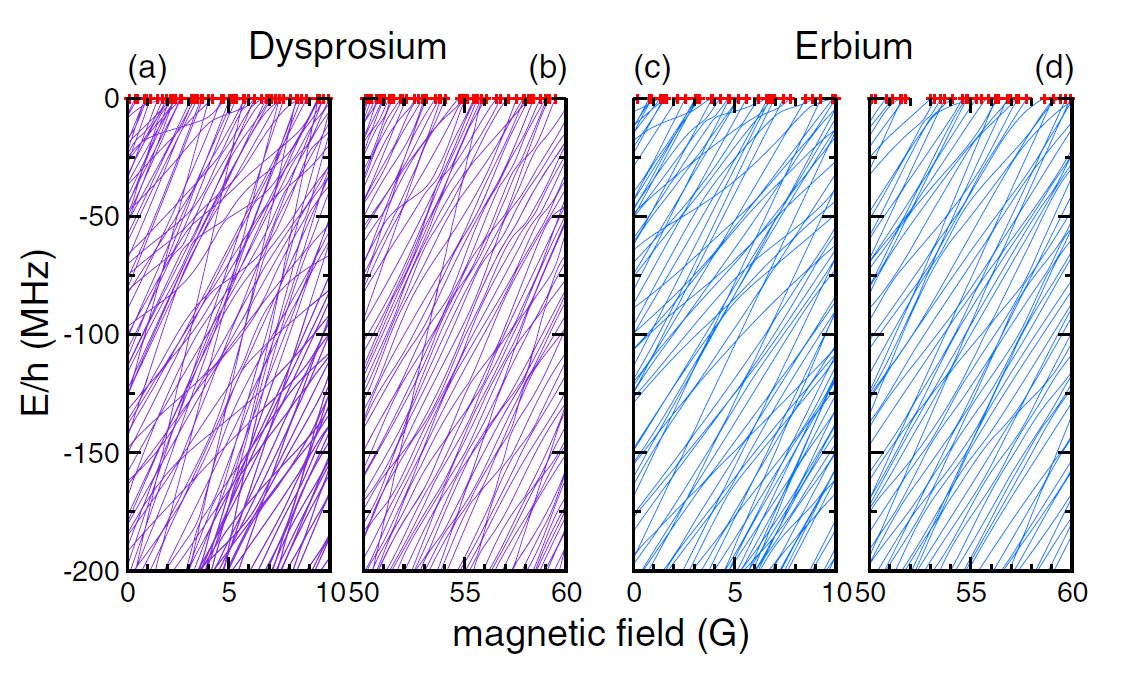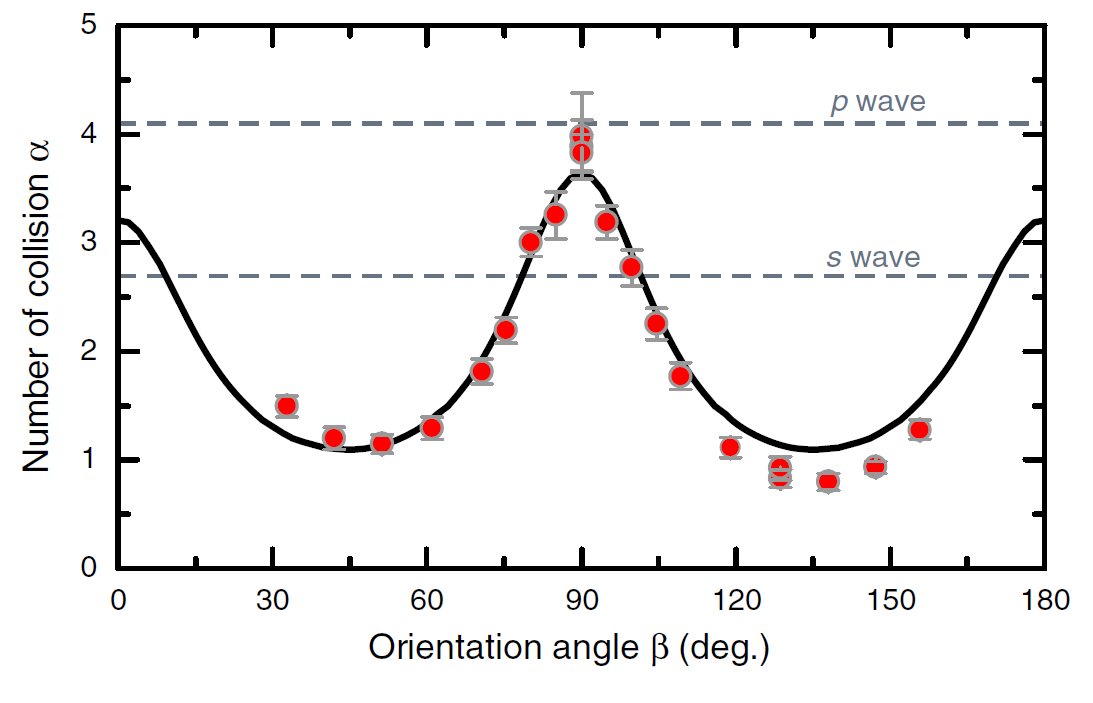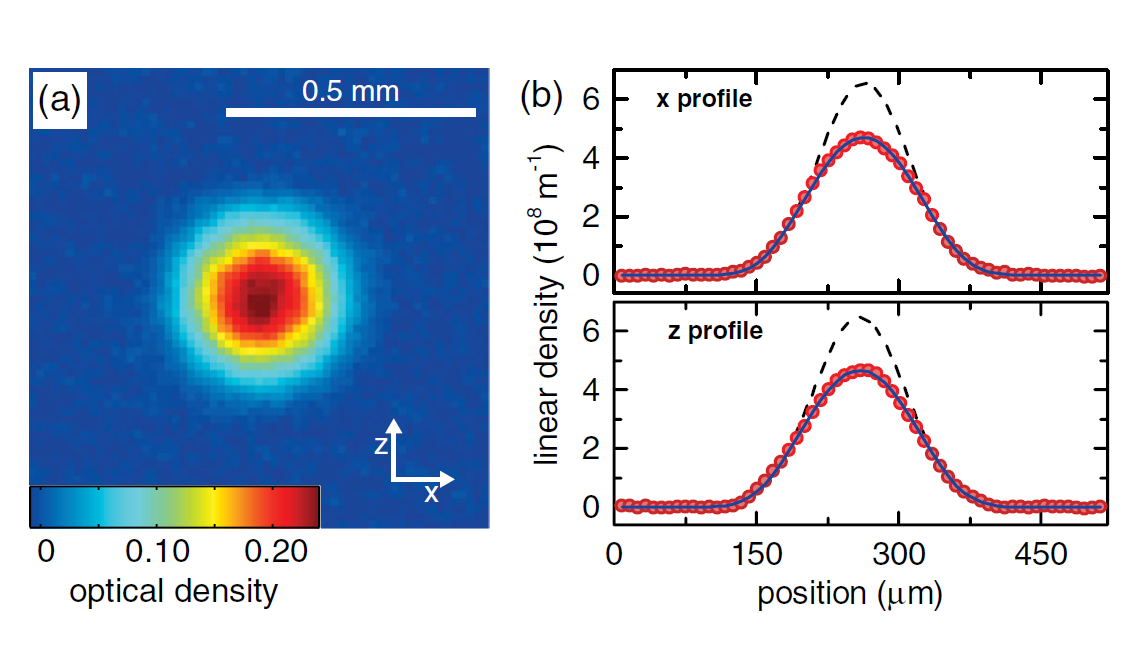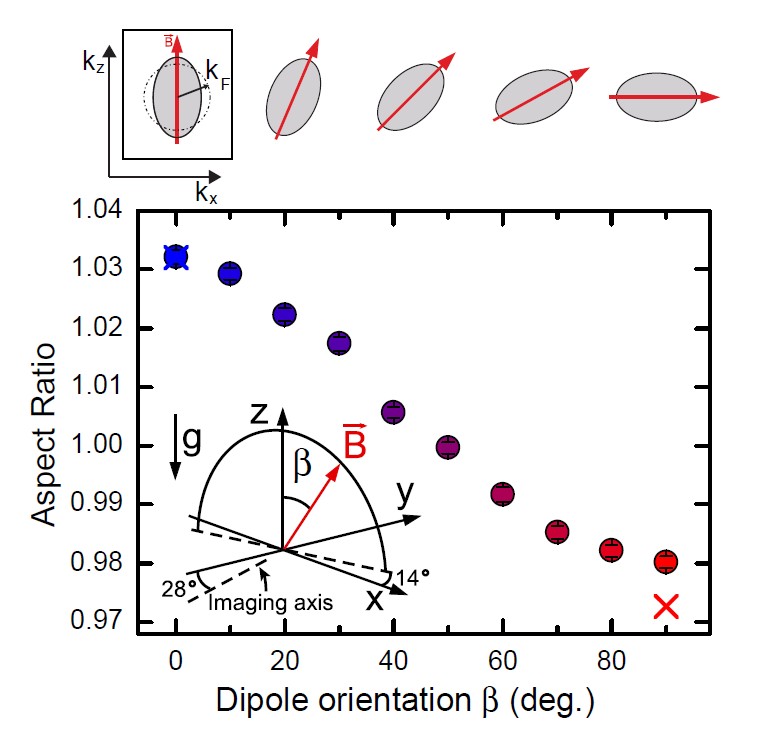For the open-source arXiv versions you can have a look here.
2023
Krutyanskiy, V.; Galli, M.; Krcmarsky, V.; Baier, S.; Fioretto, D. A.; Pu, Y.; Mazloom, A.; Sekatski, P.; Canteri, M.; Teller, M.; Schupp, J.; Bate, J.; Meraner, M.; Sangouard, N.; Lanyon, B. P.; Northup, T. E.
Entanglement of Trapped-Ion Qubits Separated by 230 Meters Artikel
In: Phys. Rev. Lett., Bd. 130, Ausg. 5, S. 050803, 2023.
@article{Krutyanskiy_ion_entanglement_2023,
title = {Entanglement of Trapped-Ion Qubits Separated by 230 Meters},
author = {V. Krutyanskiy and M. Galli and V. Krcmarsky and S. Baier and D. A. Fioretto and Y. Pu and A. Mazloom and P. Sekatski and M. Canteri and M. Teller and J. Schupp and J. Bate and M. Meraner and N. Sangouard and B. P. Lanyon and T. E. Northup},
url = {https://link.aps.org/doi/10.1103/PhysRevLett.130.050803},
doi = {10.1103/PhysRevLett.130.050803},
year = {2023},
date = {2023-02-02},
urldate = {2023-02-01},
journal = {Phys. Rev. Lett.},
volume = {130},
issue = {5},
pages = {050803},
publisher = {American Physical Society},
abstract = {We report on an elementary quantum network of two atomic ions separated by 230 m. The ions are trapped in different buildings and connected with 520(2) m of optical fiber. At each network node, the electronic state of an ion is entangled with the polarization state of a single cavity photon; subsequent to interference of the photons at a beam splitter, photon detection heralds entanglement between the two ions. Fidelities of up to (88.0+2.2−4.7)% are achieved with respect to a maximally entangled Bell state, with a success probability of 4×10^−5. We analyze the routes to improve these metrics, paving the way for long-distance networks of entangled quantum processors.},
keywords = {},
pubstate = {published},
tppubtype = {article}
}
Hermans, S L N; Pompili, M; Martins, L Dos Santos; Montblanch, A R-P; Beukers, H K C; Baier, S; Borregaard, J; Hanson, R
In: New Journal of Physics, Bd. 25, Nr. 1, S. 013011, 2023.
@article{Hermans_single_photon_protocol_2023,
title = {Entangling remote qubits using the single-photon protocol: an in-depth theoretical and experimental study},
author = {S L N Hermans and M Pompili and L Dos Santos Martins and A R-P Montblanch and H K C Beukers and S Baier and J Borregaard and R Hanson},
url = {https://dx.doi.org/10.1088/1367-2630/acb004},
doi = {10.1088/1367-2630/acb004},
year = {2023},
date = {2023-01-18},
urldate = {2023-01-18},
journal = {New Journal of Physics},
volume = {25},
number = {1},
pages = {013011},
publisher = {IOP Publishing},
abstract = {The generation of entanglement between remote matter qubits has developed into a key capability for fundamental investigations as well as for emerging quantum technologies. In the single-photon, protocol entanglement is heralded by generation of qubit-photon entangled states and subsequent detection of a single photon behind a beam splitter. In this work we perform a detailed theoretical and experimental investigation of this protocol and its various sources of infidelity. We develop an extensive theoretical model and subsequently tailor it to our experimental setting, based on nitrogen-vacancy centers in diamond. Experimentally, we verify the model by generating remote states for varying phase and amplitudes of the initial qubit superposition states and varying optical phase difference of the photons arriving at the beam splitter. We show that a static frequency offset between the optical transitions of the qubits leads to an entangled state phase that depends on the photon detection time. We find that the implementation of a Charge-Resonance check on the nitrogen-vacancy center yields transform-limited linewidths. Moreover, we measure the probability of double optical excitation, a significant source of infidelity, as a function of the power of the excitation pulse. Finally, we find that imperfect optical excitation can lead to a detection-arm-dependent entangled state fidelity and rate. The conclusion presented here are not specific to the nitrogen-vacancy centers used to carry out the experiments, and are therefore readily applicable to other qubit platforms.},
keywords = {},
pubstate = {published},
tppubtype = {article}
}
2022
Bradley, C. E.; Bone, S. W.; Moller, P. F. W.; Baier, S.; Degen, M. J.; Loenen, S. J. H.; Bartling, H. P.; Markham, M.; Twitchen, D. J.; Hanson, R.; Elkouss, D.; Taminiau, T. H.
Robust quantum-network memory based on spin qubits in isotopically engineered diamond Artikel
In: npj Quantum Information, Bd. 8, Nr. 1, S. 122, 2022, ISSN: 2056-6387.
@article{Bradley_Memory_2021,
title = {Robust quantum-network memory based on spin qubits in isotopically engineered diamond},
author = {C. E. Bradley and S. W. Bone and P. F. W. Moller and S. Baier and M. J. Degen and S. J. H. Loenen and H. P. Bartling and M. Markham and D. J. Twitchen and R. Hanson and D. Elkouss and T. H. Taminiau},
url = {https://doi.org/10.1038/s41534-022-00637-w},
doi = {10.1038/s41534-022-00637-w},
issn = {2056-6387},
year = {2022},
date = {2022-10-18},
urldate = {2021-11-18},
journal = {npj Quantum Information},
volume = {8},
number = {1},
pages = {122},
abstract = {Quantum networks can enable quantum communication and modular quantum computation. A powerful approach is to use multi-qubit nodes that provide quantum memory and computational power. Nuclear spins associated with defects in diamond are promising qubits for this role. However, dephasing during optical entanglement distribution hinders scaling to larger systems. Here, we show that a 13C-spin quantum memory in isotopically engineered diamond is robust to the optical link operation of a nitrogen-vacancy centre. The memory lifetime is improved by two orders-of-magnitude upon the state-of-the-art, surpassing reported times for entanglement distribution. Additionally, we demonstrate that the nuclear-spin state can survive ionisation and recapture of the nitrogen-vacancy electron. Finally, we use simulations to show that combining this memory with previously demonstrated entanglement links and gates can enable key network primitives, such as deterministic non-local two-qubit gates, paving the way for test-bed quantum networks capable of investigating complex algorithms and error correction.},
keywords = {},
pubstate = {published},
tppubtype = {article}
}
Patscheider, A.; Chomaz, L.; Natale, G.; Petter, D.; Mark, M. J.; Baier, S.; Yang, B.; Wang, R. R. W.; Bohn, J. L.; Ferlaino, F.
Determination of the scattering length of erbium atoms Artikel
In: Phys. Rev. A, Bd. 105, Ausg. 6, S. 063307, 2022.
@article{Patscheider_ScattLen_2022,
title = {Determination of the scattering length of erbium atoms},
author = {A. Patscheider and L. Chomaz and G. Natale and D. Petter and M. J. Mark and S. Baier and B. Yang and R. R. W. Wang and J. L. Bohn and F. Ferlaino},
url = {https://link.aps.org/doi/10.1103/PhysRevA.105.063307},
doi = {10.1103/PhysRevA.105.063307},
year = {2022},
date = {2022-06-08},
urldate = {2022-06-01},
journal = {Phys. Rev. A},
volume = {105},
issue = {6},
pages = {063307},
publisher = {American Physical Society},
abstract = {An accurate knowledge of the scattering length is fundamental in ultracold quantum gas experiments and essential for the characterisation of the system as well as for a meaningful comparison to theoretical models. Here, we perform a careful characterisation of the s-wave scattering length a_s for the four highest-abundance isotopes of erbium, in the magnetic field range from 0G to 5G. We report on cross-dimensional thermalization measurements and apply the Enskog equations of change to numerically simulate the thermalization process and to analytically extract an expression for the so-called number of collisions per re-thermalization (NCPR) to obtain a_s from our experimental data. We benchmark the applied cross-dimensional thermalization technique with the experimentally more demanding lattice modulation spectroscopy and find good agreement for our parameter regime. Our experiments are compatible with a dependence of the NCPR with a_s, as theoretically expected in the case of strongly dipolar gases. Surprisingly, we experimentally observe a dependency of the NCPR on the density, which might arise due to deviations from an ideal harmonic trapping configuration. Finally, we apply a model for the dependency of the background scattering length with the isotope mass, allowing to estimate the number of bound states of erbium.},
keywords = {},
pubstate = {published},
tppubtype = {article}
}
Hermans, S. L. N.; Pompili, M.; Beukers, H. K. C.; Baier, S.; Borregaard, J.; Hanson, R.
Qubit teleportation between non-neighbouring nodes in a quantum network Artikel
In: Nature, Bd. 605, Nr. 7911, S. 663-668, 2022, ISSN: 1476-4687.
@article{Hermans_Teleport_2022,
title = {Qubit teleportation between non-neighbouring nodes in a quantum network},
author = {S. L. N. Hermans and M. Pompili and H. K. C. Beukers and S. Baier and J. Borregaard and R. Hanson},
url = {https://doi.org/10.1038/s41586-022-04697-y},
doi = {10.1038/s41586-022-04697-y},
issn = {1476-4687},
year = {2022},
date = {2022-05-25},
urldate = {2022-05-25},
journal = {Nature},
volume = {605},
number = {7911},
pages = {663-668},
abstract = {Future quantum internet applications will derive their power from the ability to share quantum information across the network. Quantum teleportation allows for the reliable transfer of quantum information between distant nodes, even in the presence of highly lossy network connections. Although many experimental demonstrations have been performed on different quantum network platforms, moving beyond directly connected nodes has, so far, been hindered by the demanding requirements on the pre-shared remote entanglement, joint qubit readout and coherence times. Here we realize quantum teleportation between remote, non-neighbouring nodes in a quantum network. The network uses three optically connected nodes based on solid-state spin qubits. The teleporter is prepared by establishing remote entanglement on the two links, followed by entanglement swapping on the middle node and storage in a memory qubit. We demonstrate that, once successful preparation of the teleporter is heralded, arbitrary qubit states can be teleported with fidelity above the classical bound, even with unit efficiency. These results are enabled by key innovations in the qubit readout procedure, active memory qubit protection during entanglement generation and tailored heralding that reduces remote entanglement infidelities. Our work demonstrates a prime building block for future quantum networks and opens the door to exploring teleportation-based multi-node protocols and applications.},
keywords = {},
pubstate = {published},
tppubtype = {article}
}
2021
Pompili*, M.; Hermans*, S. L. N.; Baier*, S.; Beukers, H. K. C.; Humphreys, P. C.; Schouten, R. N.; Vermeulen, R. F. L.; Tiggelman, M. J.; Martins, L. Santos; Dirkse, B.; Wehner, S.; Hanson, R.; *equal contribution,
Realization of a multinode quantum network of remote solid-state qubits Artikel
In: Science, Bd. 372, Nr. 6539, S. 259–264, 2021, ISSN: 0036-8075.
@article{Pompili259,
title = {Realization of a multinode quantum network of remote solid-state qubits},
author = {M. Pompili* and S. L. N. Hermans* and S. Baier* and H. K. C. Beukers and P. C. Humphreys and R. N. Schouten and R. F. L. Vermeulen and M. J. Tiggelman and L. Santos Martins and B. Dirkse and S. Wehner and R. Hanson and *equal contribution},
url = {https://science.sciencemag.org/content/372/6539/259},
doi = {10.1126/science.abg1919},
issn = {0036-8075},
year = {2021},
date = {2021-01-01},
urldate = {2021-01-01},
journal = {Science},
volume = {372},
number = {6539},
pages = {259--264},
publisher = {American Association for the Advancement of Science},
abstract = {Future quantum networks will provide the means to develop truly secure communication channels and will have applications in many other quantum-based technologies. In this work we present a three-node remote quantum network based on solid-state spin qubits (nitrogen-vacancy centers in diamond) coupled by photons. The implementation of two quantum protocols on the network. entanglement distribution and entanglement swapping, illustrates a key platform for exploring, testing, and developing multinode quantum networks and quantum protocols.
},
keywords = {},
pubstate = {published},
tppubtype = {article}
}
2020
Baier*, S.; Bradley*, C. E.; Middelburg, T.; Dobrovitski, V. V.; Taminiau, T. H.; Hanson, R.; *equal contribution,
Orbital and Spin Dynamics of Single Neutrally-Charged Nitrogen-Vacancy Centers in Diamond Artikel
In: Phys. Rev. Lett., Bd. 125, S. 193601, 2020.
@article{PhysRevLett.125.193601,
title = {Orbital and Spin Dynamics of Single Neutrally-Charged Nitrogen-Vacancy Centers in Diamond},
author = {S. Baier* and C. E. Bradley* and T. Middelburg and V. V. Dobrovitski and T. H. Taminiau and R. Hanson and *equal contribution},
url = {https://link.aps.org/doi/10.1103/PhysRevLett.125.193601},
doi = {10.1103/PhysRevLett.125.193601},
year = {2020},
date = {2020-11-01},
urldate = {2020-11-01},
journal = {Phys. Rev. Lett.},
volume = {125},
pages = {193601},
publisher = {American Physical Society},
abstract = {The neutral charge state plays an important role in quantum information and sensing applications based on nitrogen-vacancy centers. However, the orbital and spin dynamics remain unexplored. Here, we use resonant excitation of single centers to directly reveal the fine structure, enabling selective addressing of spin-orbit states. Through pump-probe experiments, we find the orbital relaxation time (430 ns at 4.7 K) and measure its temperature dependence up to 11.8 K. Finally, we reveal the spin relaxation time (1.5 s) and realize projective high-fidelity single-shot readout of the spin state (≥98%).},
keywords = {},
pubstate = {published},
tppubtype = {article}
}
Patscheider, A.; Zhu, B.; Chomaz, L.; Petter, D.; Baier, S.; Rey, A. -M.; Ferlaino, F.; Mark, M. J.
Controlling dipolar exchange interactions in a dense three-dimensional array of large-spin fermions Artikel
In: Phys. Rev. Research, Bd. 2, S. 023050, 2020.
@article{PhysRevResearch.2.023050,
title = {Controlling dipolar exchange interactions in a dense three-dimensional array of large-spin fermions},
author = {A. Patscheider and B. Zhu and L. Chomaz and D. Petter and S. Baier and A. -M. Rey and F. Ferlaino and M. J. Mark},
url = {https://link.aps.org/doi/10.1103/PhysRevResearch.2.023050},
doi = {10.1103/PhysRevResearch.2.023050},
year = {2020},
date = {2020-04-01},
urldate = {2020-04-01},
journal = {Phys. Rev. Research},
volume = {2},
pages = {023050},
publisher = {American Physical Society},
abstract = {Dipolar interactions are ubiquitous in nature and rule the behavior of a broad range of systems spanning from energy transfer in biological systems to quantum magnetism. Here we study magnetization-conserving dipolar induced spin-exchange dynamics in dense arrays of fermionic erbium atoms confined in a deep three-dimensional lattice. Harnessing the special atomic properties of erbium, we demonstrate control over the spin dynamics by tuning the dipole orientation and changing the initial spin state within the large 20-spin hyperfine manifold. Furthermore, we demonstrate the capability to quickly turn on and off the dipolar exchange dynamics via optical control. The experimental observations are in excellent quantitative agreement with numerical calculations based on discrete phase-space methods, which capture entanglement and beyond-mean-field effects. Our experiment sets the stage for future explorations of rich magnetic behaviors in long-range interacting dipoles, including exotic phases of matter and applications for quantum information processing.},
keywords = {},
pubstate = {published},
tppubtype = {article}
}
2018
Veljić, V.; Lima, A. R. P.; Chomaz, L.; Baier, S.; Mark, M. J.; Ferlaino, F.; Pelster, A.; Balaž, A.
Ground state of an ultracold Fermi gas of tilted dipoles in elongated traps Artikel
In: New Journal of Physics, Bd. 20, Nr. 9, S. 093016, 2018.
@article{Velji__2018,
title = {Ground state of an ultracold Fermi gas of tilted dipoles in elongated traps},
author = {V. Veljić and A. R. P. Lima and L. Chomaz and S. Baier and M. J. Mark and F. Ferlaino and A. Pelster and A. Balaž},
url = {https://doi.org/10.1088/1367-2630/aade24},
doi = {10.1088/1367-2630/aade24},
year = {2018},
date = {2018-09-01},
urldate = {2018-09-01},
journal = {New Journal of Physics},
volume = {20},
number = {9},
pages = {093016},
publisher = {IOP Publishing},
abstract = {Many-body dipolar effects in Fermi gases are quite subtle as they energetically compete with the large kinetic energy at and below the Fermi surface (FS). Recently it was experimentally observed in a sample of erbium atoms that its FS is deformed from a sphere to an ellipsoid due to the presence of the anisotropic and long-range dipole–dipole interaction Aikawa et al (2014 Science 345 1484). Moreover, it was suggested that, when the dipoles are rotated by means of an external field, the FS follows their rotation, thereby keeping the major axis of the momentum-space ellipsoid parallel to the dipoles. Here we generalise a previous Hartree–Fock mean-field theory to systems confined in an elongated triaxial trap with an arbitrary orientation of the dipoles relative to the trap. With this we study for the first time the effects of the dipoles’ arbitrary orientation on the ground-state properties of the system. Furthermore, taking into account the geometry of the system, we show how the ellipsoidal FS deformation can be reconstructed, assuming ballistic expansion, from the experimentally measurable real-space aspect ratio after a free expansion. We compare our theoretical results with new experimental data measured with erbium Fermi gas for various trap parameters and dipole orientations. The observed remarkable agreement demonstrates the ability of our model to capture the full angular dependence of the FS deformation. Moreover, for systems with even higher dipole moment, our theory predicts an additional unexpected effect: the FS does not simply follow rigidly the orientation of the dipoles, but softens showing a change in the aspect ratio depending on the dipoles’ orientation relative to the trap geometry, as well as on the trap anisotropy itself. Our theory provides the basis for understanding and interpreting phenomena in which the investigated physics depends on the underlying structure of the FS, such as fermionic pairing and superfluidity.},
keywords = {},
pubstate = {published},
tppubtype = {article}
}
Baier, S.; Petter, D.; Becher, J. H.; Patscheider, A.; Natale, G.; Chomaz, L.; Mark, M. J.; Ferlaino, F.
Realization of a Strongly Interacting Fermi Gas of Dipolar Atoms Artikel
In: Phys. Rev. Lett., Bd. 121, S. 093602, 2018.
@article{PhysRevLett.121.093602,
title = {Realization of a Strongly Interacting Fermi Gas of Dipolar Atoms},
author = {S. Baier and D. Petter and J. H. Becher and A. Patscheider and G. Natale and L. Chomaz and M. J. Mark and F. Ferlaino},
url = {https://link.aps.org/doi/10.1103/PhysRevLett.121.093602},
doi = {10.1103/PhysRevLett.121.093602},
year = {2018},
date = {2018-08-01},
urldate = {2018-08-01},
journal = {Phys. Rev. Lett.},
volume = {121},
pages = {093602},
publisher = {American Physical Society},
abstract = {We realize a two-component dipolar Fermi gas with tunable interactions, using erbium atoms. Employing a lattice-protection technique, we selectively prepare deeply degenerate mixtures of the two lowest spin states and perform high-resolution Feshbach spectroscopy in an optical dipole trap. We identify a comparatively broad Feshbach resonance and map the interspin scattering length in its vicinity. The Fermi mixture shows a remarkable collisional stability in the strongly interacting regime, providing a first step towards studies of superfluid pairing, crossing from Cooper pairs to bound molecules, in presence of dipole-dipole interactions.},
keywords = {},
pubstate = {published},
tppubtype = {article}
}
Chomaz, L.; Bijnen, R. M. W.; Petter, D.; Faraoni, G.; Baier, S.; Becher, J. H.; Mark, M. J.; Wächtler, F.; Santos, L.; Ferlaino, F.
Observation of roton mode population in a dipolar quantum gas Artikel
In: Nature Physics, Bd. 14, S. 442-446, 2018.
@article{Chomaz2018Oor,
title = {Observation of roton mode population in a dipolar quantum gas},
author = {L. Chomaz and R. M. W. Bijnen and D. Petter and G. Faraoni and S. Baier and J. H. Becher and M. J. Mark and F. Wächtler and L. Santos and F. Ferlaino},
url = {https://doi.org/10.1038/s41567-018-0054-7},
doi = {10.1038/s41567-018-0054-7},
year = {2018},
date = {2018-03-01},
urldate = {2018-03-01},
journal = {Nature Physics},
volume = {14},
pages = {442-446},
abstract = {The concept of a roton, a special kind of elementary excitation forming a minimum of energy at finite momentum, has been essential for the understanding of the properties of superfluid 4He. In quantum liquids, rotons arise from the strong interparticle interactions, whose microscopic description remains debated. In the realm of highly controllable quantum gases, a roton mode has been predicted to emerge due to magnetic dipole–dipole interactions despite their weakly interacting character. This prospect has raised considerable interest; yet roton modes in dipolar quantum gases have remained elusive to observations. Here we report experimental and theoretical studies of the momentum distribution in Bose–Einstein condensates of highly magnetic erbium atoms, revealing the existence of the long-sought roton mode. Following an interaction quench, the roton mode manifests itself with the appearance of symmetric peaks at well-defined finite momentum. The roton momentum follows the predicted geometrical scaling with the inverse of the confinement length along the magnetization axis. From the growth of the roton population, we probe the roton softening of the excitation spectrum in time and extract the corresponding imaginary roton gap. Our results provide a further step in the quest towards supersolidity in dipolar quantum gases.},
keywords = {},
pubstate = {published},
tppubtype = {article}
}
Becher*, J. H.; Baier*, S.; Aikawa, K.; Lepers, M.; Wyart, J. -F.; Dulieu, O.; Ferlaino, F.; *equal contribution,
Anisotropic polarizability of erbium atoms Artikel
In: Phys. Rev. A, Bd. 97, S. 012509, 2018.
@article{PhysRevA.97.012509,
title = {Anisotropic polarizability of erbium atoms},
author = {J. H. Becher* and S. Baier* and K. Aikawa and M. Lepers and J. -F. Wyart and O. Dulieu and F. Ferlaino and *equal contribution},
url = {https://link.aps.org/doi/10.1103/PhysRevA.97.012509},
doi = {10.1103/PhysRevA.97.012509},
year = {2018},
date = {2018-01-01},
urldate = {2018-01-01},
journal = {Phys. Rev. A},
volume = {97},
pages = {012509},
publisher = {American Physical Society},
abstract = {We report on the determination of the dynamical polarizability of ultracold erbium atoms in the ground and in one excited state at three different wavelengths, which are particularly relevant for optical trapping. Our study combines experimental measurements of the light shift and theoretical calculations. In particular, our experimental approach allows us to isolate the different contributions to the polarizability, namely, the isotropic scalar and anisotropic tensor part. For the latter contribution, we observe a clear dependence of the atomic polarizability on the angle between the laser-field-polarization axis and the quantization axis, set by the external magnetic field. Such an angle dependence is particularly pronounced in the excited-state polarizability. We compare our experimental findings with the theoretical values, based on semiempirical electronic structure calculations, and we observe a very good overall agreement. Our results pave the way to exploit the anisotropy of the tensor polarizability for spin-selective preparation and manipulation.},
keywords = {},
pubstate = {published},
tppubtype = {article}
}
2016
Chomaz, L.; Baier, S.; Petter, D.; Mark, M. J.; Wächtler, F.; Santos, L.; Ferlaino, F.
In: Phys. Rev. X, Bd. 6, S. 041039, 2016.
@article{PhysRevX.6.041039,
title = {Quantum-Fluctuation-Driven Crossover from a Dilute Bose-Einstein Condensate to a Macrodroplet in a Dipolar Quantum Fluid},
author = {L. Chomaz and S. Baier and D. Petter and M. J. Mark and F. Wächtler and L. Santos and F. Ferlaino},
url = {https://link.aps.org/doi/10.1103/PhysRevX.6.041039},
doi = {10.1103/PhysRevX.6.041039},
year = {2016},
date = {2016-11-01},
urldate = {2016-11-01},
journal = {Phys. Rev. X},
volume = {6},
pages = {041039},
publisher = {American Physical Society},
abstract = {In a joint experimental and theoretical effort, we report on the formation of a macrodroplet state in an ultracold bosonic gas of erbium atoms with strong dipolar interactions. By precise tuning of the s-wave scattering length below the so-called dipolar length, we observe a smooth crossover of the ground state from a dilute Bose-Einstein condensate to a dense macrodroplet state of more than 2x10^4 atoms. Based on the study of collective excitations and loss features, we prove that quantum fluctuations stabilize the ultracold gas far beyond the instability threshold imposed by mean-field interactions. Finally, we perform expansion measurements, showing that although self-bound solutions are prevented by losses, the interplay between quantum stabilization and losses results in a minimal time-of-flight expansion velocity at a finite scattering length.},
keywords = {},
pubstate = {published},
tppubtype = {article}
}
Baier, S.; Mark, M. J.; Petter, D.; Aikawa, K.; Chomaz, L.; Cai, Z.; Baranov, M.; Zoller, P.; Ferlaino, F.
Extended Bose-Hubbard models with ultracold magnetic atoms Artikel
In: Science, Bd. 352, Nr. 6282, S. 201–205, 2016, ISSN: 0036-8075.
@article{Baier201,
title = {Extended Bose-Hubbard models with ultracold magnetic atoms},
author = {S. Baier and M. J. Mark and D. Petter and K. Aikawa and L. Chomaz and Z. Cai and M. Baranov and P. Zoller and F. Ferlaino},
url = {https://science.sciencemag.org/content/352/6282/201},
doi = {10.1126/science.aac9812},
issn = {0036-8075},
year = {2016},
date = {2016-01-01},
urldate = {2016-01-01},
journal = {Science},
volume = {352},
number = {6282},
pages = {201--205},
publisher = {American Association for the Advancement of Science},
abstract = {Two magnets interact with each other through a force that depends on the distance between them and on their mutual orientation. How do these long-range dipolar forces affect the behavior of a system of many magnets? Baier et al. used a gas of erbium atoms, which have a large magnetic moment, to answer this question. The gas, which they housed in an optical lattice, underwent a transition from a superfluid to an insulating state, revealing the presence of dipolar interactions through the orientation dependence of various properties.Science, this issue p. 201The Hubbard model underlies our understanding of strongly correlated materials. Whereas its standard form only comprises interactions between particles at the same lattice site, extending it to encompass long-range interactions is predicted to profoundly alter the quantum behavior of the system. We realize the extended Bose-Hubbard model for an ultracold gas of strongly magnetic erbium atoms in a three-dimensional optical lattice. Controlling the orientation of the atomic dipoles, we reveal the anisotropic character of the onsite interaction and hopping dynamics and their influence on the superfluid-to-Mott insulator quantum phase transition. Moreover, we observe nearest-neighbor interactions, a genuine consequence of the long-range nature of dipolar interactions. Our results lay the groundwork for future studies of exotic many-body quantum phases.},
keywords = {},
pubstate = {published},
tppubtype = {article}
}
2015
Frisch, A.; Mark, M.; Aikawa, K.; Baier, S.; Grimm, R.; Petrov, A.; Kotochigova, S.; Quéméner, G.; Lepers, M.; Dulieu, O.; Ferlaino, F.
Ultracold Dipolar Molecules Composed of Strongly Magnetic Atoms Artikel
In: Phys. Rev. Lett., Bd. 115, S. 203201, 2015.
@article{PhysRevLett.115.203201,
title = {Ultracold Dipolar Molecules Composed of Strongly Magnetic Atoms},
author = {A. Frisch and M. Mark and K. Aikawa and S. Baier and R. Grimm and A. Petrov and S. Kotochigova and G. Quéméner and M. Lepers and O. Dulieu and F. Ferlaino},
url = {https://link.aps.org/doi/10.1103/PhysRevLett.115.203201},
doi = {10.1103/PhysRevLett.115.203201},
year = {2015},
date = {2015-11-01},
urldate = {2015-11-01},
journal = {Phys. Rev. Lett.},
volume = {115},
pages = {203201},
publisher = {American Physical Society},
abstract = {In a combined experimental and theoretical effort, we demonstrate a novel type of dipolar system made of ultracold bosonic dipolar molecules with large magnetic dipole moments. Our dipolar molecules are formed in weakly bound Feshbach molecular states from a sample of strongly magnetic bosonic erbium atoms. We show that the ultracold magnetic molecules can carry very large dipole moments and we demonstrate how to create and characterize them, and how to change their orientation. Finally, we confirm that the relaxation rates of molecules in a quasi-two-dimensional geometry can be reduced by using the anisotropy of the dipole-dipole interaction and that this reduction follows a universal dipolar behavior.},
keywords = {},
pubstate = {published},
tppubtype = {article}
}
Maier, T.; Kadau, H.; Schmitt, M.; Wenzel, M.; Ferrier-Barbut, I.; Pfau, T.; Frisch, A.; Baier, S.; Aikawa, K.; Chomaz, L.; Mark, M. J.; Ferlaino, F.; Makrides, C.; Tiesinga, E.; Petrov, A.; Kotochigova, S.
Emergence of Chaotic Scattering in Ultracold Er and Dy Artikel
In: Phys. Rev. X, Bd. 5, S. 041029, 2015.
@article{PhysRevX.5.041029,
title = {Emergence of Chaotic Scattering in Ultracold Er and Dy},
author = {T. Maier and H. Kadau and M. Schmitt and M. Wenzel and I. Ferrier-Barbut and T. Pfau and A. Frisch and S. Baier and K. Aikawa and L. Chomaz and M. J. Mark and F. Ferlaino and C. Makrides and E. Tiesinga and A. Petrov and S. Kotochigova},
url = {https://link.aps.org/doi/10.1103/PhysRevX.5.041029},
doi = {10.1103/PhysRevX.5.041029},
year = {2015},
date = {2015-11-01},
urldate = {2015-11-01},
journal = {Phys. Rev. X},
volume = {5},
pages = {041029},
publisher = {American Physical Society},
abstract = {We show that for ultracold magnetic lanthanide atoms chaotic scattering emerges due to a combination of anisotropic interaction potentials and Zeeman coupling under an external magnetic field. This scattering is studied in a collaborative experimental and theoretical effort for both dysprosium and erbium. We present extensive atom-loss measurements of their dense magnetic Feshbach-resonance spectra, analyze their statistical properties, and compare to predictions from a random-matrix-theory-inspired model. Furthermore, theoretical coupled-channels simulations of the anisotropic molecular Hamiltonian at zero magnetic field show that weakly bound, near threshold diatomic levels form overlapping, uncoupled chaotic series that when combined are randomly distributed. The Zeeman interaction shifts and couples these levels, leading to a Feshbach spectrum of zero-energy bound states with nearest-neighbor spacings that changes from randomly to chaotically distributed for increasing magnetic field. Finally, we show that the extreme temperature sensitivity of a small, but sizable fraction of the resonances in the Dy and Er atom-loss spectra is due to resonant nonzero partial-wave collisions. Our threshold analysis for these resonances indicates a large collision-energy dependence of the three-body recombination rate.},
keywords = {},
pubstate = {published},
tppubtype = {article}
}
2014
Aikawa, K.; Frisch, A.; Mark, M.; Baier, S.; Grimm, R.; Bohn, J. L.; Jin, D. S.; Bruun, G. M.; Ferlaino, F.
Anisotropic Relaxation Dynamics in a Dipolar Fermi Gas Driven Out of Equilibrium Artikel
In: Phys. Rev. Lett., Bd. 113, S. 263201, 2014.
@article{PhysRevLett.113.263201,
title = {Anisotropic Relaxation Dynamics in a Dipolar Fermi Gas Driven Out of Equilibrium},
author = {K. Aikawa and A. Frisch and M. Mark and S. Baier and R. Grimm and J. L. Bohn and D. S. Jin and G. M. Bruun and F. Ferlaino},
url = {https://link.aps.org/doi/10.1103/PhysRevLett.113.263201},
doi = {10.1103/PhysRevLett.113.263201},
year = {2014},
date = {2014-12-01},
urldate = {2014-12-01},
journal = {Phys. Rev. Lett.},
volume = {113},
pages = {263201},
publisher = {American Physical Society},
abstract = {We report on the observation of a large anisotropy in the rethermalization dynamics of an ultracold dipolar Fermi gas driven out of equilibrium. Our system consists of an ultracold sample of strongly magnetic $^167$Er fermions, spin polarized in the lowest Zeeman sublevel. In this system, elastic collisions arise purely from universal dipolar scattering. Based on cross-dimensional rethermalization experiments, we observe a strong anisotropy of the scattering, which manifests itself in a large angular dependence of the thermal relaxation dynamics. Our result is in good agreement with recent theoretical predictions. Furthermore, we measure the rethermalization rate as a function of temperature for different angles and find that the suppression of collisions by Pauli blocking is not influenced by the dipole orientation.},
keywords = {},
pubstate = {published},
tppubtype = {article}
}
Aikawa, K.; Frisch, A.; Mark, M.; Baier, S.; Grimm, R.; Ferlaino, F.
Reaching Fermi Degeneracy via Universal Dipolar Scattering Artikel
In: Phys. Rev. Lett., Bd. 112, S. 010404, 2014.
@article{PhysRevLett.112.010404,
title = {Reaching Fermi Degeneracy via Universal Dipolar Scattering},
author = {K. Aikawa and A. Frisch and M. Mark and S. Baier and R. Grimm and F. Ferlaino},
url = {https://link.aps.org/doi/10.1103/PhysRevLett.112.010404},
doi = {10.1103/PhysRevLett.112.010404},
year = {2014},
date = {2014-01-01},
urldate = {2014-01-01},
journal = {Phys. Rev. Lett.},
volume = {112},
pages = {010404},
publisher = {American Physical Society},
abstract = {We report on the creation of a degenerate dipolar Fermi gas of erbium atoms. We force evaporative cooling in a fully spin-polarized sample down to temperatures as low as 0.2 times the Fermi temperature. The strong magnetic dipole-dipole interaction enables elastic collisions between identical fermions even in the zero-energy limit. The measured elastic scattering cross section agrees well with the predictions from the dipolar scattering theory, which follow a universal scaling law depending only on the dipole moment and on the atomic mass. Our approach to quantum degeneracy proceeds with very high cooling efficiency and provides large atomic densities, and it may be extended to various dipolar systems.},
keywords = {},
pubstate = {published},
tppubtype = {article}
}
Aikawa, K.; Baier, S.; Frisch, A.; Mark, M.; Ravensbergen, C.; Ferlaino, F.
Observation of Fermi surface deformation in a dipolar quantum gas Artikel
In: Science, Bd. 345, Nr. 6203, S. 1484–1487, 2014, ISSN: 0036-8075.
@article{Aikawa1484,
title = {Observation of Fermi surface deformation in a dipolar quantum gas},
author = {K. Aikawa and S. Baier and A. Frisch and M. Mark and C. Ravensbergen and F. Ferlaino},
url = {https://science.sciencemag.org/content/345/6203/1484},
doi = {10.1126/science.1255259},
issn = {0036-8075},
year = {2014},
date = {2014-01-01},
urldate = {2014-01-01},
journal = {Science},
volume = {345},
number = {6203},
pages = {1484--1487},
publisher = {American Association for the Advancement of Science},
abstract = {When a bunch of fermions get together, they obey the Pauli exclusion principle: No two fermions can be in the same quantum state. The fermions populate the available states, starting from those lowest in energy. The boundary between the empty and filled states is called the Fermi surface (FS). For cold gases of fermionic atoms in the lab, the FS is usually spherical. Now, Aikawa et al. observe the FS squishing in a gas of Er atoms, which behave like tiny magnets and align with their magnetic field environment. The squishing reflects the very directional interactions between the Er atoms. ABSTRACT: In the presence of isotropic interactions, the Fermi surface of an ultracold Fermi gas is spherical. Introducing anisotropic interactions can deform the Fermi surface, but the effect is subtle and challenging to observe experimentally. Here, we report on the observation of a Fermi surface deformation in a degenerate dipolar Fermi gas of erbium atoms. The deformation is caused by the interplay between strong magnetic dipole-dipole interaction and the Pauli exclusion principle. We demonstrate the many-body nature of the effect and its tunability with the Fermi energy. Our observation provides a basis for future studies on anisotropic many-body phenomena in normal and superfluid phases.},
keywords = {},
pubstate = {published},
tppubtype = {article}
}
2012
Aikawa, K.; Frisch, A.; Mark, M.; Baier, S.; Rietzler, A.; Grimm, R.; Ferlaino, F.
Bose-Einstein Condensation of Erbium Artikel
In: Phys. Rev. Lett., Bd. 108, S. 210401, 2012.
@article{PhysRevLett.108.210401,
title = {Bose-Einstein Condensation of Erbium},
author = {K. Aikawa and A. Frisch and M. Mark and S. Baier and A. Rietzler and R. Grimm and F. Ferlaino},
url = {https://link.aps.org/doi/10.1103/PhysRevLett.108.210401},
doi = {10.1103/PhysRevLett.108.210401},
year = {2012},
date = {2012-05-01},
urldate = {2012-05-01},
journal = {Phys. Rev. Lett.},
volume = {108},
pages = {210401},
publisher = {American Physical Society},
abstract = {We report on the achievement of Bose-Einstein condensation of erbium atoms and on the observation of magnetic Feshbach resonances at low magnetic fields. By means of evaporative cooling in an optical dipole trap, we produce pure condensates of $^168$Er, containing up to 7x10^4 atoms. Feshbach spectroscopy reveals an extraordinary rich loss spectrum with six loss resonances already in a narrow magnetic-field range up to 3 G. Finally, we demonstrate the application of a low-field Feshbach resonance to produce a tunable dipolar Bose-Einstein condensate and we observe its characteristic d-wave collapse.},
keywords = {},
pubstate = {published},
tppubtype = {article}
}
2018
Baier, Simon
PhD thesis: Ultracold Dipolar Erbium Atoms: From Scattering Phenomena to Quantum Simulations Promotionsarbeit
2018.
@phdthesis{BaierPhD,
title = {PhD thesis: Ultracold Dipolar Erbium Atoms: From Scattering Phenomena to Quantum Simulations},
author = {Simon Baier},
url = {https://diglib.uibk.ac.at/ulbtirolhs/download/pdf/2565727?originalFilename=true},
year = {2018},
date = {2018-10-01},
urldate = {2018-10-01},
journal = {PhD Thesis},
abstract = {Remarkable progress in the field of experimental quantum physics has enabled the preparation of quantum systems across various experimental platforms. The ability to precisely control and manipulate quantum states by experimental means, allows to study fundamental laws of quantum mechanics and their impact at the many-body level. Ultracold atomic gases are a powerful and flexible platform, providing precise control of key parameters, such as temperature, density, internal and external degrees of freedom, dimensionality, or the trapping geometry. With the access of controllable interparticle interaction, a plethora of fascinating quantum phenomena has been observed. While the field was pioneered along studies with short-range contact interaction, nowadays dipolar interactions, featuring a long-range and anisotropic character, are attracting a large attention within the community.
This thesis reports on the investigation of quantum phenomena emerging from dipolar interactions. As a workhorse for our studies, we use ultracold gases of strongly magnetic erbium atoms. Erbium has first been Bose-Einstein condensed in 2012 in our laboratory. Shortly after, we created the first degenerate Fermi gas of erbium. This thesis focuses on the use of both systems as a resource to investigate dipolar quantum phenomena from the few- to the many-body level. With dipolar fermions, we unveil the universal character of ultracold dipolar scattering, enabling a unique path towards quantum degenerate identical fermions. We further observe a peculiar dependence of the total elastic scattering cross section on the dipole orientation. The few-body collisional physics also impacts the behavior of the system at the many-body level. Reporting on the first observation of a many-body effect in a dipolar Fermi gas, we demonstrate the deformation of the Fermi surface. With bosonic particles, we investigate the origin of a strong level repulsion in Feshbach spectra of magnetic lanthanides and trace it back to the anisotropic van der Waals interaction among the atoms. Utilizing Feshbach resonances, we report on the first production of dipolar Feshbach molecules and reveal a universal behavior of the stabilization of inelastic losses in reduced dimensions by dipolar interactions.
As a major step towards strongly correlated dipolar systems, we investigate the system's behavior in a three-dimensional optical lattice. In particular, we report on the realization of extended Hubbard models with dipolar bosonic and fermionic atoms. In bosonic systems, we directly observe nearest-neighbor interactions activated by the long-range dipolar interaction. We demonstrate the strengthening or weakening of the Mott insulator quantum many-body phase via solely changing the dipole orientation. For the fermionic counterpart, we add the spin-degree of freedom, giving rise to a large spin-19/2 system. A lattice protection technique allows to investigate in detail the elastic collisional properties of a two-state mixture. With our method, we realize for the first time a strongly interacting dipolar Fermi gas. The successful preparation of extended spinor Fermi Hubbard systems brings exciting prospects for future investigations at the interface with solid state physics. Offsite terms emerging from dipolar interactions give rise to clustered states, exotic lattice spin models, resonant demagnetization dynamics, or exotic quantum phases.},
keywords = {},
pubstate = {published},
tppubtype = {phdthesis}
}
This thesis reports on the investigation of quantum phenomena emerging from dipolar interactions. As a workhorse for our studies, we use ultracold gases of strongly magnetic erbium atoms. Erbium has first been Bose-Einstein condensed in 2012 in our laboratory. Shortly after, we created the first degenerate Fermi gas of erbium. This thesis focuses on the use of both systems as a resource to investigate dipolar quantum phenomena from the few- to the many-body level. With dipolar fermions, we unveil the universal character of ultracold dipolar scattering, enabling a unique path towards quantum degenerate identical fermions. We further observe a peculiar dependence of the total elastic scattering cross section on the dipole orientation. The few-body collisional physics also impacts the behavior of the system at the many-body level. Reporting on the first observation of a many-body effect in a dipolar Fermi gas, we demonstrate the deformation of the Fermi surface. With bosonic particles, we investigate the origin of a strong level repulsion in Feshbach spectra of magnetic lanthanides and trace it back to the anisotropic van der Waals interaction among the atoms. Utilizing Feshbach resonances, we report on the first production of dipolar Feshbach molecules and reveal a universal behavior of the stabilization of inelastic losses in reduced dimensions by dipolar interactions.
As a major step towards strongly correlated dipolar systems, we investigate the system’s behavior in a three-dimensional optical lattice. In particular, we report on the realization of extended Hubbard models with dipolar bosonic and fermionic atoms. In bosonic systems, we directly observe nearest-neighbor interactions activated by the long-range dipolar interaction. We demonstrate the strengthening or weakening of the Mott insulator quantum many-body phase via solely changing the dipole orientation. For the fermionic counterpart, we add the spin-degree of freedom, giving rise to a large spin-19/2 system. A lattice protection technique allows to investigate in detail the elastic collisional properties of a two-state mixture. With our method, we realize for the first time a strongly interacting dipolar Fermi gas. The successful preparation of extended spinor Fermi Hubbard systems brings exciting prospects for future investigations at the interface with solid state physics. Offsite terms emerging from dipolar interactions give rise to clustered states, exotic lattice spin models, resonant demagnetization dynamics, or exotic quantum phases.
2012
Baier, Simon
Master thesis: An optical dipole trap for Erbium with tunable geometry Diplomarbeit
2012.
@diplomathesis{BaierMSc,
title = {Master thesis: An optical dipole trap for Erbium with tunable geometry},
author = {Simon Baier},
url = {https://www.baiersimon.eu/wp-content/uploads/2021/10/MASTERTHESIS-Baier-Simon.pdf},
year = {2012},
date = {2012-10-01},
urldate = {2012-10-01},
journal = {Master's Thesis},
abstract = {In this thesis, we describe the realization of a novel optical dipole trap for erbium atoms. The trap is based on time-averaged potentials and is thus tunable in geometry. We investigate both theoretically and experimentally the dynamic polarizability of ground-state erbium atoms. The polarizability is a very important quantity for the understanding of the atomic properties of erbium and, prior to this thesis, its value was unknown. We measure a dynamic polarizability of Re(α)=(84±2±18) a.u. for erbium atoms in a 1064-nm laser field, which is 47% lower than the one we calculated based on the best knowledge of the erbium atomic spectrum. This discrepancy might points to a too rough knowledge of the atomic level structure or to novel unexpected effects arising in sub-merged shell atoms. Further investigations both in theory and experiments are highly needed. For our novel optical dipole trap setup we use a scanning system consisting of an acousto-optical modulator, electronics and a customized optical setup. The dipole trap beam is shifted perpendicular to its horizontal axis, creating time-averaged potentials when the scan over a range of positions is fast enough compared to the trap frequency. The aspect ratio of the dipole trap can be tuned from 1.5 to 15. With the new dipole trap system we can load up to 35% of MOT atoms to the dipole trap, which is related to mode-matching arguments. Further the density at each evaporation step can be optimized, leading to a large overall evaporation efficiency of 3.5. This improvements result in up to three times larger numbers in the pure BEC compared to our previous experiments. With the new tunable dipole trap we are confident that in future we can investigate geometry-dependent anisotropic quantum effects, unique to dipolar gases.},
keywords = {},
pubstate = {published},
tppubtype = {diplomathesis}
}
